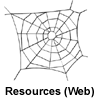|
|
 |
The
required readings for this unit are:
 Australia
Australia |
Required
Reading(s)
|
 |
Insert article
here
 Canada
Canada |
Required
Reading(s)
|
 |
Insert article
here
 International
International |
Required
Reading(s)
|
 |
Insert article
here
 United Kingdom
United Kingdom |
Required
Reading(s)
|
 |
Insert article
here
 United States
United States |
Required
Reading(s)
|
 |
Morrison,
C. (1999). Cameras in hospital rooms: The Fourth Amendment
to the Constitution and Munchausen syndrome by proxy.
Critical Care Nursing Quarterly, 22(1), 65-68.Retrieved
December 26, 2002, from Academic Search Premier database:
http://search.epnet.com/direct.asp?an=6822536&db=aph
- Note
the legal issues surrounding covert video surveillance
in the United States.
- Does
the Fourth Amendment to the Constitution protect
the rights of children or the child abusers? Munchausen
syndrome by proxy (MSBP): the mother, the child,
and the nurse on convert video surveillance in hospitals.
|
Databases
For the full text article online,
sleuth the 'University
of Calgary/ Library/ Article Indexes':
Directions:
- Select
- Indexes and abstracts with links to full text articles
- Select
- Academic Search Premier or Expanded Academic ASAP
- Select
- Connect
-
Fill in
User ID and Pin
- Fill
in search words:
- media
and technology and laws
- child
and pornography
Top of Page
|
 |
 |
The
'recommended only' readings for this unit are the following:
 Australia
Australia |
Recommended
Reading(s)
|
 |
Insert article/book/chapter
here
 Canada
Canada |
Recommended
Reading(s)
|
 |
Insert article/book/chapter
here
 International
International |
Recommended
Reading(s)
|
 |
Insert article/book/chapter
here
 United Kingdom
United Kingdom |
Recommended
Reading(s)
|
 |
Bates, A. (1999).
The Newsworthiness of crime. The British Journal of Forensic
Practice, 1 (2), 22-27.
- Note this
article examines the position of crime, criminal or deviant
behavior in the hierarchy of newsworthiness, and explores
some ways in which public services are protecting themselves
from the dangers of unwanted media attention (Bates, 1999,
p. 22).
Gulland, A.
(1998). Abuse spies and videotapes. Nursing Times, 94
(45), 12-13.
- Note the
concerns over ethics and reliability of covert video surveillance.
Mercer, D. &
McKeown, M. (1997). Pornography, Politics and Practice:
The Implications for Nursing. Health Care Analysis,
5, 1, 56-61.
- Note the
harm-based legal definition of pornography developed at
Ashworth Special Hospital (Mason & Mercer, 1997, p.
59).
 United States
United States |
Recommended
Reading(s)
|
 |
Elias, C.
(2001). Beyond our borders: The critical issues in global
health today. Western Journal of Medicine, 175(3),
155-158.
-
Elias discusses various issues, interventions, technologies,
and developments that affect the health and well-being
of people and communities in less developed countries.
Elias discusses issues that include women's and
children's health, vaccines, and the prevention
of the HIV and AIDS viruses.
- Note
- In the past 15 years, many new technologies have
been developed that can be implemented in low-resource
settings to assist in diagnosis and in the prevention
of disease and its transmission (Elias, 2001).
Kahana, T., Goldstein, S., Kugel, C., & Hiss,
J. (2002). Identification of human remains through
comparison of computerized tomography and radiography
plates. Journal of Forensic Identification, 52(2),
151-158. Retrieved July 2, 2002, from ProQuest database.
- Scientific
identification of human remains is frequently accomplished
by comparing antemortem and postmortem radiographic
(X-ray) data. Positive identification of a decomposed
cadaver was achieved by comparing antemortem computerized
tomography images of the head with postmortem cranial
radiographs, and antemortem with postmortem radiographs
depicting staples within the abdomen.
Official
Position Statement of National Commission on Correctional
Health Care. (1999). Use of Telemedicine Technology
in Correctional Facilities, Journal of Correctional
Health Care, 6(1), 129-137.
Official
Position Statement of National Commission on Correctional
Health Care. (1999). Use of automated external defibrillators
in correctional facilities. Journal of Correctional
Health Care, 6(1), 139-144.
Vess, J.
(2001). Implementation of a computer assisted treatment
planning and outcome evaluation system in a forensic
psychiatric hospital. Psychiatric Rehabilitation Journal,
25(2), 124-132. Retrieved July 2, 2002 from ProQuest
database.
- Vess
describes the implementation of a computer assisted
treatment planning and outcome evaluation process
in a forensic psychiatric state hospital with a
census of approximately 1000 patients.
|
Top of Page
|

|
Additional
references for this unit can be found in 'forensic
references'
of the forensic sourcebooks.
- Sleuth
'forensic reference' database for:
- media
and technology and laws
- child
and pornography
Top of Page
|

|
Video's
recommended for this unit are:
|
|
Resources
(Video)
|
 |
Insert video
here
Top of Page
|

|
 |
The
required websites to sleuth for this unit are the following:
 Australia
Australia |
Resources
(Web)
|
 |
Insert website
here
 Canada
Canada |
Resources
(Web)
|
 |
Electronic Frontier
Canada. (1997, January).Child Pornography - definition/law
in Canada from Criminal Code of Canada 1892. Retrieved June14,
2002 from http://insight.mcmaster.ca/org/efc/pages/law/cc/cc.163.1.html
- Note the
definition of child pornography as defined by the Criminal
Code of Canada.
Electronic Frontier
Canada. (1997, January 1). Electronic Frontier Canada (EFC)
(La Frontière Électronique du Canada). Retrieved
from http://www.efc.ca
- Electronic
Frontier Canada (EFC) was founded to ensure that the principles
embodied in the Canadian Charter of Rights and Freedoms
remain protected as new computing, communications, and
information technologies are introduced into Canadian
society.
Electronic
Frontier Canada. (1997, January). R. v. Sharpe. Electronic
Frontier Canada (EFC) (La Frontière Électronique
du Canada) Retrieved June 10, 2002 from: http://insight.cas.mcmaster.ca/org/efc/
- Note the
court decisions relating to the controversial case of
R.v. Sharpe in regarding child pornography law in Canada.
- R. v. Sharpe
(Supreme Court of Canada) (26jan01)
- R. v. Sharpe
(Court of Appeal) (30jun99)
- R. v. Sharpe
(Supreme Court of British Columbia) (13jan99)
 International
International |
Resources
(Web)
|
 |
Insert website
here
 United Kingdom
United Kingdom |
Resources
(Web)
|
 |
Insert website
here
 United States
United States
|
Resources
(Web)
|
 |
Enough is enough.
(2002). Pornography is a Public Health & Safety Issue.
Retrieved June 14m 2002 from http://www.enough.org/
- Note this
website Enough is Enough who's objective is to protect
children and families from the dangers of illegal Pornography
and On-Line Predators.
Top of Page
|
 |
For
additional websites on this unit, sleuth 'forensic
websites' in the forensic sourcebooks.
- Media - technology
and laws
- child - pornography
Top of Page
|
 |
|